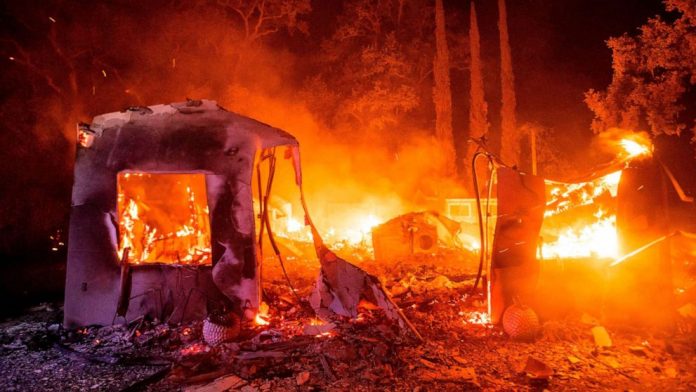With the California wildfires happening, how do such natural disasters start and spread? What can I do to safeguard my home and family, and is investing in fire-proofing or special insurance worthwhile?.
California is no stranger to wildfires. Each year, millions of acres burn, devastating communities, destroying homes, and threatening lives. While these natural disasters are often linked to the state’s hot, dry summers, understanding how wildfires start and spread, and taking steps to safeguard your property, is essential for anyone living in or near fire-prone areas. In this article, we’ll explore how wildfires develop, ways you can protect your home and family, and whether investing in fire-proofing or special insurance is a worthwhile decision.
Table of Contents
Toggle1. How Do Wildfires Start and Spread?
The Role of Weather Conditions
Wildfires are influenced by several environmental factors, with weather conditions playing a significant role. High temperatures, low humidity, and strong winds create ideal conditions for fires to ignite and spread rapidly. In California, summer heatwaves combined with seasonal winds like the Santa Ana winds can quickly escalate a fire, making it harder for firefighters to contain.
These extreme weather conditions dry out vegetation, turning it into fuel for fires. When lightning strikes or human activity—such as discarded cigarettes, unattended campfires, or sparks from equipment—introduces an ignition source, the fire can start small but spread fast.
The Spread of Wildfires
Once a wildfire ignites, its spread depends on factors like terrain, vegetation type, and wind speed. Steep, mountainous terrain can make firefighting efforts difficult, as fires tend to move uphill. Vegetation such as dry brush, grass, and trees provide ample fuel, allowing the fire to grow quickly. High winds can further accelerate the spread, carrying embers for miles and sparking new fires far from the original ignition point.
Fire Behavior: Fast or Slow?
- Crown Fires: These fires spread rapidly by jumping from tree to tree, burning the tops of trees rather than the ground level. They are the most dangerous and hardest to control.
- Surface Fires: These fires burn low to the ground and can often be controlled more easily than crown fires, but they can still spread quickly, especially in dry conditions.
2. Safeguarding Your Home and Family
Creating Defensible Space
One of the most important ways to protect your home from wildfires is by creating defensible space around it. This is the area between your home and the wildland that is maintained to reduce fire risk. The space should be free of dead plants, trees, and other combustibles.
To create defensible space:
- Clear debris: Rake leaves, twigs, and dead vegetation regularly.
- Trim trees: Remove dead branches and trim trees to create a buffer zone.
- Install fire-resistant plants: Use plants with low flammability, such as succulents and irrigated lawns.
- Maintain your roof and gutters: Ensure they are clear of leaves and other debris that could catch fire.
Fire-Resistant Building Materials
If you live in an area with a high fire risk, consider upgrading your home’s building materials. Fire-resistant materials like metal roofing, fire-rated siding, and tempered glass windows can greatly reduce the risk of your home catching fire. Additionally, enclosing eaves and vents with fire-resistant mesh can help prevent embers from entering your home.
Emergency Preparedness
In addition to preparing your home, you should have an emergency plan in place for your family. Make sure everyone knows:
- Evacuation routes: Identify at least two routes to leave your area safely.
- Meeting points: Choose safe places where family members can meet if separated.
- Emergency kits: Pack an emergency kit with essentials such as food, water, medications, and important documents.
3. Fire-Proofing Your Property: Is It Worth It?
Investing in Fire-Proofing
Fire-proofing your home is an investment that can greatly enhance its resilience to wildfires. Fireproofing includes using fire-resistant materials for your roof, siding, and windows, as well as clearing vegetation around your property. While fire-proofing can be expensive, it can offer peace of mind knowing that your home is better protected in the event of a wildfire.
For example, installing fire-resistant windows that are designed to withstand high heat can make a significant difference in preventing flames from entering your home. Similarly, replacing wooden decks and fences with metal or composite materials can help minimize your home’s exposure to flames.
While fire-proofing may not guarantee that your home will survive a wildfire, it can slow the spread of flames and increase the chances of your home remaining intact during a fire.
Is Fire-Proofing Worth the Cost?
For many homeowners, the cost of fire-proofing is justified by the potential to save their property and ensure the safety of their family. Considering that wildfires in California can cause billions of dollars in damage, investing in protective measures now can save you money in the long run by reducing the risk of catastrophic loss. Additionally, fireproofing can increase your property value and appeal to potential buyers who prioritize safety.
4. Special Insurance for Wildfire Protection
Homeowners Insurance: Standard vs. Specialized Coverage
While standard homeowners insurance covers fire damage, it may not provide sufficient coverage in the event of a large-scale wildfire. For those living in high-risk areas, it’s advisable to seek out specialized wildfire insurance policies that offer more comprehensive protection.
These specialized policies typically cover:
- Additional living expenses if you need to evacuate your home due to a wildfire.
- Loss of landscaping and other outdoor structures that may be destroyed by fire.
- Rebuilding costs that reflect the rising cost of labor and materials after a disaster.
Before purchasing insurance, it’s important to review your policy carefully and ensure it covers wildfire-specific risks, such as smoke damage and the cost of fire mitigation.
Fire Insurance Costs: Are They Worth It?
While wildfire insurance can be costly, especially in high-risk areas, it provides crucial protection for homeowners. The rising frequency of wildfires in California makes this type of coverage especially valuable. For homeowners, having the right insurance can be the difference between financial ruin and a smooth recovery in the aftermath of a wildfire.
Be Proactive to Protect Your Home and Family
With the increasing frequency and intensity of California wildfires, it’s essential to take proactive steps to safeguard your home and family. From creating defensible space and using fire-resistant materials to investing in specialized insurance and fire-proofing, there are several strategies to reduce the risk of wildfire damage. By preparing in advance, you can ensure that both your home and your loved ones are protected, giving you the confidence to face the unpredictable nature of wildfires.








